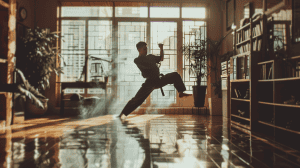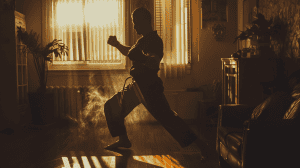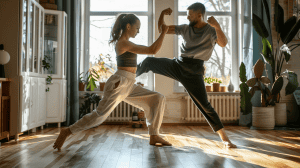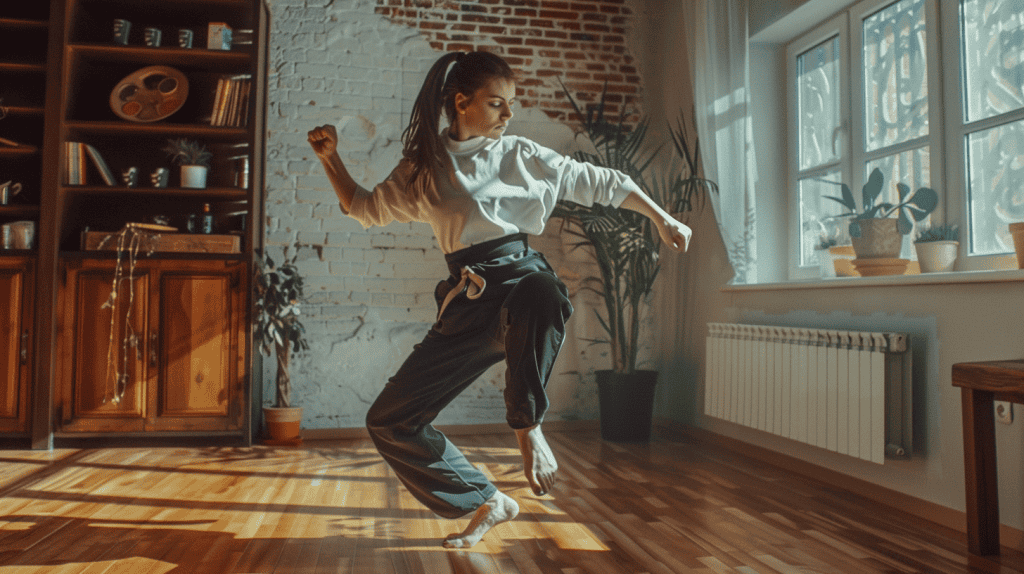To master self-defense at home, understand basics like threat recognition and de-escalation through mindfulness and conflict resolution. Designate a safe practice area, at least 6×6 feet, with padded surfaces, and guarantee good lighting. Warm up with dynamic exercises to prevent injuries, then focus on stances like neutral, forward, and side for stability and movement. Practice key strikes to critical targets and use tools like punching bags to refine techniques. Master blocks by maintaining proper guard and body positioning. Regular, varied practice drills build confidence and readiness, preparing you effectively for real-world scenarios. Next, explore more techniques and drills.
Key Takeaways
- Designate a safe practice area with at least 6 feet by 6 feet and padded surfaces.
- Begin with dynamic warm-ups and stretching to prepare muscles and reduce injury risks.
- Master fundamental stances like forward, side, cat, and horse for stability and movement.
- Practice essential strikes and kicks targeting the nose, chin, throat, and groin.
Understanding Self-Defense Basics
 Understanding self-defense basics begins with recognizing potential threats and knowing how to respond effectively. One of the first steps is to develop strong self-awareness techniques. By being mindful of your surroundings and understanding the context of a situation, you can identify potential dangers early and avoid them. Practical self-awareness involves not only observing others but also recognizing your own physical and emotional state. This awareness helps you remain calm and make rational decisions during a confrontation.
Understanding self-defense basics begins with recognizing potential threats and knowing how to respond effectively. One of the first steps is to develop strong self-awareness techniques. By being mindful of your surroundings and understanding the context of a situation, you can identify potential dangers early and avoid them. Practical self-awareness involves not only observing others but also recognizing your own physical and emotional state. This awareness helps you remain calm and make rational decisions during a confrontation.
In addition to self-awareness, mastering conflict resolution skills is essential. Effective conflict resolution can de-escalate potentially dangerous situations before they escalate into physical altercations. Techniques such as active listening, clear communication, and assertiveness can help you manage conflicts peacefully. By addressing issues calmly and directly, you can often resolve misunderstandings and reduce the likelihood of violence.
Furthermore, understanding the psychology behind aggressive behavior can aid in predicting and mitigating threats. Research indicates that many conflicts arise from miscommunication or perceived disrespect. By approaching situations with empathy and seeking to understand the other person’s perspective, you can often defuse tension.
Combining self-awareness techniques and conflict resolution strategies creates a solid foundation for effective self-defense.
Creating a Safe Practice Space
Frequently, having a designated practice space at home is essential for effective self-defense training. Such a space guarantees you can focus on learning techniques without distractions or risks of injury. Start by selecting an area with enough room to move freely—at least 6 feet by 6 feet is recommended. Clear the space of any obstacles to create a safe environment.
Next, consider the type of flooring. A padded surface, such as interlocking foam mats, can reduce the impact on your joints and minimize injury risks. Check for sufficient lighting to see your movements clearly, reducing accidents.
Incorporate the necessary practice equipment to enhance your training. For instance, a punching bag or a set of focus mitts can be invaluable for practicing strikes. Resistance bands and agility cones can aid in building strength and coordination. Verify all equipment is stable and in good condition to avoid malfunctions during practice.
Lastly, maintain the cleanliness and organization of your practice space. A tidy environment promotes safety and efficiency. Regularly inspect the area and equipment to confirm they remain in prime condition, preventing potential hazards. Following these steps will create a conducive space for mastering self-defense techniques.
Warm-Up and Stretching
 Before attempting self-defense techniques, you must warm up and stretch to prepare your body and prevent injuries. Dynamic warm-ups are vital as they increase your heart rate, improve blood flow to your muscles, and enhance your overall performance. Flexibility exercises, on the other hand, are key to maintaining a full range of motion, which is essential for executing self-defense moves effectively.
Before attempting self-defense techniques, you must warm up and stretch to prepare your body and prevent injuries. Dynamic warm-ups are vital as they increase your heart rate, improve blood flow to your muscles, and enhance your overall performance. Flexibility exercises, on the other hand, are key to maintaining a full range of motion, which is essential for executing self-defense moves effectively.
Here’s a quick table to guide you through a balanced warm-up and stretching routine:
| Exercise | Description |
|---|---|
| High Knees | Jog in place, lifting your knees to waist level. |
| Arm Circles | Extend your arms and rotate them in small, then large circles. |
| Hip Rotations | Place hands on hips and rotate your hips in a circular motion. |
| Leg Swings | Hold onto a sturdy object, swing one leg forward and backward, then sideways. |
Incorporating these dynamic warm-ups helps loosen up your muscles and ligaments, making them more pliable. Flexibility exercises such as stretches for your hamstrings, quadriceps, and shoulders guarantee that you’re less prone to strains and sprains. Remember, a proper warm-up and stretching routine sets the foundation for effective and safe self-defense practice.
Fundamental Stances and Footwork
To master self-defense at home, you’ll need to understand the principles of a balanced stance, effective foot positioning, and maintaining movement and stability.
A balanced stance guarantees you’re grounded and ready to react, while proper foot positioning allows for quick, efficient movements.
Balanced Stance Principles
 Mastering balanced stance principles, including fundamental stances and footwork, is essential for effective self-defense at home. Understanding balance dynamics allows you to maintain stability while executing defensive moves. This stability is vital because it enables you to react quickly and effectively to potential threats.
Mastering balanced stance principles, including fundamental stances and footwork, is essential for effective self-defense at home. Understanding balance dynamics allows you to maintain stability while executing defensive moves. This stability is vital because it enables you to react quickly and effectively to potential threats.
First, let’s discuss stance variations. The most common stances are neutral, front, and back. In a neutral stance, you stand with your feet shoulder-width apart, knees slightly bent, and weight evenly distributed. This provides a solid base for quick movements in any direction.
The front stance, on the other hand, places one foot forward and the other back, distributing your weight more on the front foot. This position is excellent for offensive moves like punches.
Finally, the back stance shifts your weight to the rear foot, ideal for defensive maneuvers and counter-attacks.
Footwork complements these stances by ensuring fluid movement while maintaining balance. Practicing different footwork patterns, such as stepping, pivoting, and sliding, will enhance your agility.
Effective Foot Positioning
While understanding balanced stance principles provides a solid foundation, effective foot positioning guarantees you can respond swiftly and effectively in any self-defense situation. Mastering foot placement techniques is vital for maintaining stability and enhancing your defensive and offensive maneuvers. The correct foot positioning assures you’re ready to move in any direction, making it harder for an opponent to unbalance you.
Several stance variations must be considered. The most fundamental is the neutral stance, where your feet are shoulder-width apart, knees slightly bent, and weight evenly distributed. This stance offers a balanced starting point for any movement.
The forward stance, often used in martial arts, places one foot ahead of the other, providing a solid base for strikes and blocks.
Another essential stance is the side stance, in which your body is turned sideways toward an opponent. This reduces your target area and allows for quick lateral movements.
Practicing these stance variations and learning proper foot placement techniques will greatly enhance your agility and readiness. Consistent practice will embed these techniques into muscle memory, ensuring you’re prepared and responsive in any self-defense scenario.
Movement and Stability
 Effective movement and stability in self-defense hinge on mastering fundamental stances and precise footwork. The right stance provides a solid foundation, ensuring stability and agility.
Effective movement and stability in self-defense hinge on mastering fundamental stances and precise footwork. The right stance provides a solid foundation, ensuring stability and agility.
Begin with the basic athletic stance: feet shoulder-width apart, knees slightly bent, and weight distributed evenly. This stance enhances your balance and prepares you for quick, controlled movements.
To refine your movement dynamics, practice shifting your weight fluidly from one foot to the other. This will make your changes smoother and more efficient. Incorporate stability exercises such as balancing on one leg or doing lunges to strengthen your core and lower body, which are essential for maintaining control during rapid movements.
Key stances to master include:
- Forward Stance: Enhances your ability to advance and retreat while maintaining balance.
- Side Stance: Improves lateral movements, vital for dodging attacks.
- Cat Stance: Lightens the front leg, making it easier to kick or pivot.
Consistent practice of these stances and movement exercises will greatly improve your stability, making you more resilient and reactive in self-defense scenarios.
Essential Strikes and Kicks
Learning essential strikes and kicks can greatly enhance your ability to defend yourself at home.
First, identify key target areas such as the nose, chin, throat, and groin. These are sensitive points, making them effective self-defense tools when struck properly. A well-placed punch to the nose can cause disorientation and create an opportunity to escape, while a kick to the groin can incapacitate an attacker momentarily.
Focus on perfecting your punches and kicks. For punches, use your knuckles and aim for the nose or chin. Keep your wrist straight to avoid injury. Practice jabs, crosses, and hooks to develop a versatile striking arsenal.
For kicks, the front kick and roundhouse kick are fundamental. The front kick targets the groin or stomach, using the ball of your foot to deliver a powerful blow. The roundhouse kick, aimed at the side of the knee or ribs, uses the shin or top of the foot for impact.
Consistent practice is crucial. Use a punching bag or even a sturdy pillow to simulate striking. Remember, precision and speed are more important than sheer strength.
Defensive Techniques and Blocks
 To effectively protect yourself, you need to master basic blocking techniques and understand effective defensive stances. Blocking correctly can deflect incoming attacks and prevent injury, while a strong stance provides stability and balance. Let’s explore these methods to enhance your self-defense skills at home.
To effectively protect yourself, you need to master basic blocking techniques and understand effective defensive stances. Blocking correctly can deflect incoming attacks and prevent injury, while a strong stance provides stability and balance. Let’s explore these methods to enhance your self-defense skills at home.
Basic Blocking Techniques
Mastering basic blocking techniques is vital for effectively defending yourself at home. These foundational skills can help you neutralize threats and protect yourself in various situations. Before learning advanced blocking techniques, you must perfect the basics to avoid common blocking mistakes that could leave you vulnerable.
Here are four basic blocks you should master:
- High Block: Raise your forearm to intercept strikes aimed at your head.
- Low Block: Deflect lower attacks, like kicks, by swinging your arm down.
- Inside Block: Protect your midsection by moving your forearm inward to block strikes.
Consistently practicing these blocks enhances your reflexes and builds muscle memory, which is essential for effective self-defense.
It’s important to avoid common blocking mistakes such as dropping your guard, overcommitting to a block, or failing to position your body correctly. These errors can make you more susceptible to attacks.
Research shows that proper blocking techniques greatly reduce the risk of injury during confrontations. Emphasizing the basics will set a strong foundation, ensuring you’re well-prepared for more advanced blocking techniques.
Stay focused, practice regularly, and you’ll develop the confidence and skill needed to defend yourself effectively.
Effective Defensive Stances
One of the most essential elements of self-defense at home is adopting effective defensive stances to maintain balance and readiness. A proper stance guarantees you’re grounded and prepared to react swiftly. Start with your feet shoulder-width apart, knees slightly bent, and weight balanced evenly. This basic position, often called the “neutral stance,” keeps you stable and ready to move in any direction.
Understanding defensive psychology is critical. When you’re in a defensive stance, you project confidence and control, which can deter potential attackers. Coupled with situational awareness, this mindset allows you to assess your surroundings continuously and anticipate threats before they materialize.
For instance, the staggered stance, where one foot is slightly forward, offers increased mobility and stability. This stance is particularly effective when blocking or evading strikes. Raise your hands to chest level, elbows in, forming a natural guard to protect essential areas.
Research highlights that maintaining eye contact and a strong posture reduces the likelihood of an attack. This combination of physical readiness and mental alertness creates a robust foundation for effective self-defense. Practice these stances regularly to build muscle memory and guarantee they become second nature.
Practicing Self-Defense Drills
Incorporating regular self-defense drills into your routine can greatly enhance your ability to respond effectively in a crisis. Practicing drills builds muscle memory, ensuring your body reacts instinctively when needed.
Start by focusing on self-awareness techniques, maintaining a heightened sense of your surroundings. This mental preparedness is vital for recognizing potential threats early.
When practicing drills, consider the following:
- Reaction Time: Quick responses can mean the difference between safety and danger.
- Adaptability: Train for various scenarios to handle different types of threats.
- Confidence: Regular practice boosts your confidence, making you less likely to freeze in a real situation.
Begin with basic movements like blocking and striking, gradually incorporating more complex scenarios. Visualize real-life situations to make your practice sessions more effective.
Focus on both offensive and defensive techniques, ensuring a thorough skill set. Use a mirror to check your form, and record your sessions to identify areas for improvement.
Incorporating Non-Lethal Tools into Your Home Self-Defense Training
 By incorporating non-lethal self-defense tools like stun guns, pepper sprays, and personal alarms into your home self-defense training, you’re not just enhancing your ability to protect yourself in threatening situations. You’re also empowering yourself with an additional layer of security that can be used to deter or incapacitate an attacker, giving you the confidence and control to escape and call for help.
By incorporating non-lethal self-defense tools like stun guns, pepper sprays, and personal alarms into your home self-defense training, you’re not just enhancing your ability to protect yourself in threatening situations. You’re also empowering yourself with an additional layer of security that can be used to deter or incapacitate an attacker, giving you the confidence and control to escape and call for help.
Just as with physical techniques, it is important to designate a safe and distraction-free practice area when learning how to use these tools effectively. For stun guns and pepper sprays, you may need to consider additional safety precautions, such as ensuring there are no flammable substances nearby and using practice versions of these tools designed specifically for training.
 Incorporating these tools into your training routine requires a similar process to learning physical self-defense techniques. Begin by understanding the correct usage and potential effects of each tool. For example, a stun gun requires direct contact with the attacker, targeting areas like the neck, chest, or groin for maximum effect, whereas pepper spray is designed for distance and should be aimed at the attacker’s face. Personal alarms can be activated to create a loud noise, disorienting the attacker and attracting attention.
Incorporating these tools into your training routine requires a similar process to learning physical self-defense techniques. Begin by understanding the correct usage and potential effects of each tool. For example, a stun gun requires direct contact with the attacker, targeting areas like the neck, chest, or groin for maximum effect, whereas pepper spray is designed for distance and should be aimed at the attacker’s face. Personal alarms can be activated to create a loud noise, disorienting the attacker and attracting attention.
Just as with physical techniques, it is crucial to build muscle memory through regular, consistent practice using these tools. This will ensure that you can respond quickly and effectively in a crisis situation, reducing anxiety and increasing your preparedness. Practice should include drawing the tool from its storage place, activating it, and using it on a target.
 Adding drills that incorporate these tools into your training can be a highly engaging and active way to learn. For instance, you could simulate an attack scenario where you have to quickly draw your pepper spray or stun gun and use it against an attacker. This kind of active learning can make your training more effective and enjoyable.
Adding drills that incorporate these tools into your training can be a highly engaging and active way to learn. For instance, you could simulate an attack scenario where you have to quickly draw your pepper spray or stun gun and use it against an attacker. This kind of active learning can make your training more effective and enjoyable.
Finally, just as you would record your progress with physical techniques in a training journal, do the same with these tools. This can help you identify any areas of difficulty and monitor your improvement over time. Regular practice and evaluation will ensure you are comfortable and confident using these tools, enhancing your self-defense capabilities.
Building a Training Routine
Creating an effective training routine involves setting clear goals and establishing a consistent schedule to guarantee steady progress in your self-defense skills.
Start by defining what you aim to achieve, such as mastering specific techniques or improving overall fitness. Goal setting is essential, as it provides direction and motivation. Break down larger objectives into manageable tasks, ensuring each training session has a focus.
Your training mindset is equally important. Approach each session with determination and a willingness to learn. Consistency is key; allocate specific times for training throughout the week, and stick to this schedule as closely as possible. Research indicates that regular practice enhances muscle memory and reaction times, which are vital components of self-defense.
Incorporate a mix of drills, strength training, and flexibility exercises into your routine. For instance, dedicate certain days to practicing strikes and blocks, while others can focus on cardio and strength-building. Use online resources or instructional videos to confirm you’re practicing techniques correctly. Always warm up before starting to prevent injuries.
Keep a training journal to monitor progress. Document your activities, challenges, and improvements. This practice helps you reassess goals and maintain a productive training mindset.
With dedication and structure, you’ll steadily enhance your self-defense capabilities.


